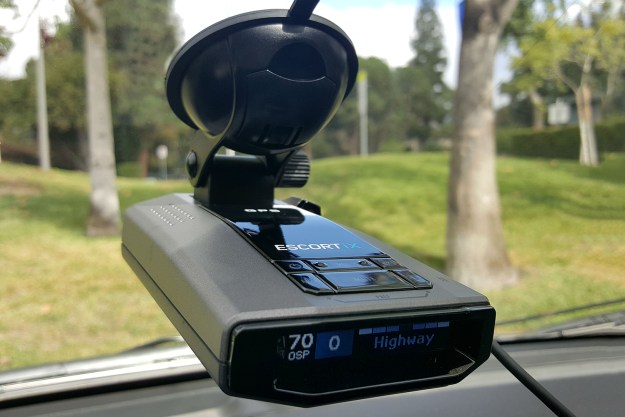
“The Escort iX improves upon the basics with fewer false alerts, new features, and notifications shared from its growing user network.”
- New update EZ Mag magnetic mount
- High range and speed of alerts
- Crowd-sourced alerts through Escort Live App
- AutoLearn feature and IVT filter to block false alarms
- Audible alerts can be difficult to hear
Escort continues to improve their product line with the latest Escort iX as an update to the outgoing Escort 9500iX. While other competitors like the Valentine One stick to the basics, the Escort brand hopes to differentiate itself with new features and a growing network or users providing crowd sourced alerts. We plugged in to see if this new iX still has what it takes to keep you alert on the road and out of traffic school.
Quality, Display, Magnetic mount, Voice
The older Escort 9500iX was a basic design with a black casing, as well as a red or blue digital display, depending on which model you chose. This new iX modernizes the look and arrives in a silver and black with the choice to view the stunning OLED display in amber, red, blue, or green. This new Escort iX shares most qualities with the Beltronics GT-7 we reviewed earlier this year, apart from an updated mounting system. Most older mounting systems rely on a metal tab to lock into place but the iX uses a fantastic “EZ Mag” magnetic mount. We found that the magnetic mount was bit more solid over time as some of the tab systems tend to get loose. The most noticeable change between the GT-7 and the Escort iX is a softer female voice that can often be difficult to decipher over driving noise when compared to the deeper and clear male voice on the Beltronics device.
Driving modes and experience
The Escort iX system includes the latest SmartCord USB power cord that plugs into your car’s 12-volt power source. The Escort SmartCord features a USB port for charging other devices while in use, a power indicator, and red alert LED lights. It’s also got a button to silence alerts without having to reach up to the actual radar unit. The Escort iX is able to detect X-band, K-Band, Ka-band, and laser signals. There are four different modes to help you dial in which alerts you will receive including Highway, Auto, Auto No X, and Auto Lo K mode.
The iX will be the perfect companion for most consumers who aren’t looking to step up into the $600+ range of the detector market.
Depending on where you drive and what local law enforcement may use will determine which setting is best. We found that the “Auto No X” which disables the X band, or “Auto Lo K,” which lowers the K band sensitivity, was the best for only giving true Ka alerts when law enforcement was present. Around most major cities, you will never see the older “X’ band and the simple “K” band signals were often from things like radar detection signs for construction warnings to slow down. On long trips, the “Highway” mode was most effective at giving alerts at the longest range, often sending alerts a mile or more before the radar source. More expensive units like the Escort Max 360 will certainly have much longer range, but the iX gave alerts in plenty of time to react. This is largely because the alerts come in quickly and there is a noticeable speed improvement when compared to older units like the 9500iX.
As you drive with the Escort iX radar detector, it can also use its AutoLearn feature to help block false alerts. When used on our standard commute, the GPS tracking within the system would start to recognize false alerts like road signs that trigger an alert at the same spot each day. Once these places are recognized, the system would start to mute the audio alert and only show it visually with an included “stored” message. Thankfully, the system can also “unlearn” a spot if it realizes that the signal is gone from that spot after a while. In addition to AutoLearn, the system also has a new IVT or “In vehicle technologies” filter that will ensure not to confuse collision avoidance systems on other cars for the radar devices it’s meant to keep an eye out for. With past radar detectors, we would get alerts triggered by the car next to us and its collision avoidance system, but the Escort iX never gave a false alert in those situations.
A little help from friends
The Escort iX differs from some of the more well known radar detectors by offering access to crowd-sourced updates via the Escort Live mobile application. Pairing through bluetooth is simple and the dashboard screen displays your speed, direction, music controls, and current radar detector mode. When paired, the crowd-sourced alerts will show up on both the app and the radar display to give you more advanced warning for what lies ahead. We had several police alerts while using the app that turned out to be accurate and gave warning ahead of the actual Ka band detection.
Our Take
For many in the in the market for a radar detector, it seems that there is no room for additional improvement beyond the basic functionality. Escort continues to find a way to improve the way their systems learn false alarms and make sure you only get the alerts you are looking to avoid. The iX will be the perfect companion for most consumers who aren’t looking to step up into the $600+ range of the detector market.
Is there a better alternative?
Despite the $500 price tag, the long range, speed of alerts, features to bock false alerts, and ability to pull crowd-sourced alerts help keep Escort’s most popular line of detectors ahead of the competition.
How long will it last?
Without a large change in the way law enforcement detects speed, we don’t see the Escort iX fading out at any time. There isn’t much more in terms of innovation within the radar space beyond the new iX and we think this is a fairly future-proof investment.
Should you buy it?
Yes. If you don’t have a radar detector or have an older model that constantly gives false alerts, then this iX will be perfect for you. Escort even offers a 1-year performance guarantee that will pay for any speeding tickets you receive while using the system. For those that own a newer Escort 9500iX or similar model from the competition, then you will simply have to decide if things like improved speed and crowd-sourced updates are enough to pay the $500 to update.
Editors' Recommendations
- BMW shows off an electric car with color-changing paint at CES 2022
- 2022 BMW i4 first drive review: The real deal
- The best radar detectors





